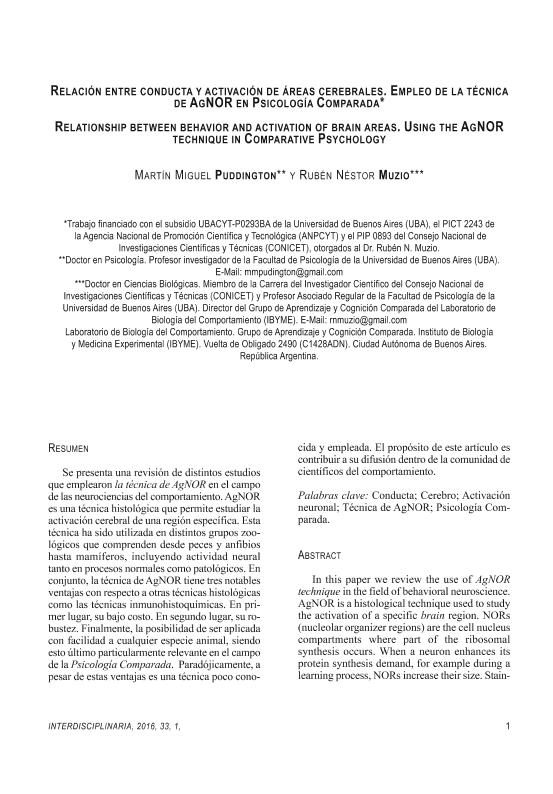Artículo
Se presenta una revisión de distintos estudios que emplearon la técnica de AgNOR en el campo de las neurociencias del comportamiento. AgNOR es una técnica histológica que permite estudiar la activación cerebral de una región específica. Esta técnica ha sido utilizada en distintos grupos zoológicos que comprenden desde peces y anfibios hasta mamíferos, incluyendo actividad neural tanto en procesos normales como patológicos. En conjunto, la técnica de AgNOR tiene tres notables ventajas con respecto a otras técnicas histológicas como las técnicas inmunohistoquímicas. En primer lugar, su bajo costo. En segundo lugar, su robustez. Finalmente, la posibilidad de ser aplicada con facilidad a cualquier especie animal, siendo esto último particularmente relevante en el campo de la Psicología Comparada. Paradójicamente, a pesar de estas ventajas es una técnica poco conocida y empleada. El propósito de este artículo es contribuir a su difusión dentro de la comunidad decientíficos del comportamiento. In this paper we review the use of AgNOR technique in the field of behavioral neuroscience. AgNOR is a histological technique used to study the activation of a specific brain region. NORs (nucleolar organizer regions) are the cell nucleus compartments where part of the ribosomal synthesis occurs. When a neuron enhances its protein synthesis demand, for example during a learning process, NORs increase their size. Staining with silver nitrate, colors the cell nucleus in brown and the cell nucleolus in dark brown, nearly black. Thus, the size of the nucleus and the nucleolus can be easily measured in histological preparations treated with silver nitrate through any appropriated image processing software. In this manner, AgNOR technique consist in staining the tissue of subjects that have received different treatments and comparing the average size of the nucleolus of a particular brain region, which is an indirect marker of cellular activity. The use of AgNOR technique in the study of neural basis of learning, typically involves: (1) training animals in a particular task, (2) after acquisition, animals in the trained group along with animals from a control condition are sacrificed in order to obtain a brain sample, (3) brains of animals from both conditions are processed and compared. This procedure was successfully used to study telencephalic activation during spatial learning in fish (Carassius auratus). The task consisted in using visual cues to identify the correct exit from a trap. In the case of fish, the histological analysis showed an increase of the nucleolus size in the lateral pallium, proposed as homologous to the mammalian hippocampus, observing that this area is involved in spatial memory. In our laboratory this technique was also used to analyze the neural activity after spatial learning in the terrestrial toad Rhinella arenarum. We conducted several studies where dehydrated animals had to use visual cues to locate the correct position of a water source. In accordance with fish’s data, our results indicated a higher activity of the hippocampal homologous region (the amphibian medial pallium), showing a high degree of functional equivalence. On the other hand, we also studied in toads the telencephalic activity during an aversive learning task. Here, it was observed an increase in the average of NORs size in the ventrolateral telencephalic region, the striatum (proposed as homologous to the mammalian amygdala), also showing a highly preserved functional equivalence. In mammals, AgNOR technique was used with different purposes, such as the study of changes in hippocampal activity during development in rats, the comparison of the basal activity of two regions of the rats hippocampus, the CA1 and the CA3, both strongly related with learning, or the the hippocampal activity in two different situations in which the liver activity was altered (by an artificial cholestasis, or by alcohol consumption). Finally, AgNOR technique was also used in the study of human brain activity of subjects that had committed suicide.
On the whole, the AgNOR technique has three distinct advantages over other histological techniques such as the immunohistochemical. First, their low cost. Second, their robustness. Finally, the fact that it can be easily applied to any animal species, which makes it particularly attractive to the field of the Comparative Psychology. But paradoxically, despite these advantages it is a poorly known and used technique. The aim of this paper is to contribute to the diffusion of the AgNOR technique in the community of behavioral scientists, showing that its use has provided a valuable contribution to research in different fields and animal species.
Relación entre conducta y activación de áreas cerebrales: empleo de la técnica de AgNOR en psicología comparada
Título:
Relationship between behavior and activation of brain areas: using the agnoR
technique in comparative psychology
Fecha de publicación:
03/2016
Editorial:
Centro Interamericano de Investigaciones Psicológicas y Ciencias Afines (CIIPCA)
Revista:
Interdisciplinaria
e-ISSN:
1668-7027
Idioma:
Español
Tipo de recurso:
Artículo publicado
Clasificación temática:
Resumen
Archivos asociados
Licencia
Identificadores
Colecciones
Articulos(IBYME)
Articulos de INST.DE BIOLOGIA Y MEDICINA EXPERIMENTAL (I)
Articulos de INST.DE BIOLOGIA Y MEDICINA EXPERIMENTAL (I)
Citación
Puddington, Martin Miguel; Muzio, Ruben Nestor; Relación entre conducta y activación de áreas cerebrales: empleo de la técnica de AgNOR en psicología comparada; Centro Interamericano de Investigaciones Psicológicas y Ciencias Afines (CIIPCA); Interdisciplinaria; 33; 1; 3-2016; 1-13
Compartir




